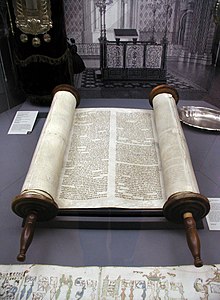 The Torah (/ˈtɔːrəˌˈtoʊrə/; Hebrew: תּוֹרָה, "Instruction, Teaching"), or the Pentateuch (/ˈpɛntəˌtuːk, -ˌtjuːk/), is the central reference of the religious Judaic tradition. It has a range of meanings. It can most specifically mean the first five books of the twenty-four books of the Tanakh, and it usually includes the perushim (rabbinic commentaries). The term "Torah" means instruction and offers a way of life for those who follow it; it can mean the continued narrative from Book of Genesis to the end of the Tanakh, and it can even mean the totality of Jewish teaching, culture and practice.[1] Common to all these meanings, Torah consists of the foundational narrative of Jewish peoplehood: their call into being by God, their trials and tribulations, and their covenant with their God, which involves following a way of life embodied in a set of moral and religious obligations and civil laws (halakha).
The Torah (/ˈtɔːrəˌˈtoʊrə/; Hebrew: תּוֹרָה, "Instruction, Teaching"), or the Pentateuch (/ˈpɛntəˌtuːk, -ˌtjuːk/), is the central reference of the religious Judaic tradition. It has a range of meanings. It can most specifically mean the first five books of the twenty-four books of the Tanakh, and it usually includes the perushim (rabbinic commentaries). The term "Torah" means instruction and offers a way of life for those who follow it; it can mean the continued narrative from Book of Genesis to the end of the Tanakh, and it can even mean the totality of Jewish teaching, culture and practice.[1] Common to all these meanings, Torah consists of the foundational narrative of Jewish peoplehood: their call into being by God, their trials and tribulations, and their covenant with their God, which involves following a way of life embodied in a set of moral and religious obligations and civil laws (halakha).
In rabbinic literature the word "Torah" denotes both the five books (Hebrew: תורה שבכתב "Torah that is written") as well as the Oral Torah (תורה שבעל פה, "Torah that is spoken"). The Oral Torah consists of interpretations and amplifications which according to rabbinic tradition have been handed down from generation to generation and are now embodied in the Talmud and Midrash.[2]
According to rabbinic tradition, all of the teachings found in the Torah, both written and oral, were given by God through Moses, a prophet, some of them at Mount Sinai and others at the Tabernacle, and all the teachings were written down by Moses, which resulted in the Torah we have today. According to a Midrash, the Torah was created prior to the creation of the world, and was used as the blueprint for Creation.[3]
The majority of Biblical scholars believe that the written books were a product of the Babylonian captivity (c. 600 BCE), based on earlier written and oral traditions, and that it was completed by the period of Achaemenid rule (c. 400 BCE).[4][5]
Traditionally, the words of the Torah are written on a scroll by a sofer on parchment in Hebrew. A Torah portion is read publicly at least once every three days in the halachically-prescribed tune, in the presence of a congregation.[6] Reading the Torah publicly is one of the bases for Jewish communal life.
No comments:
Post a Comment